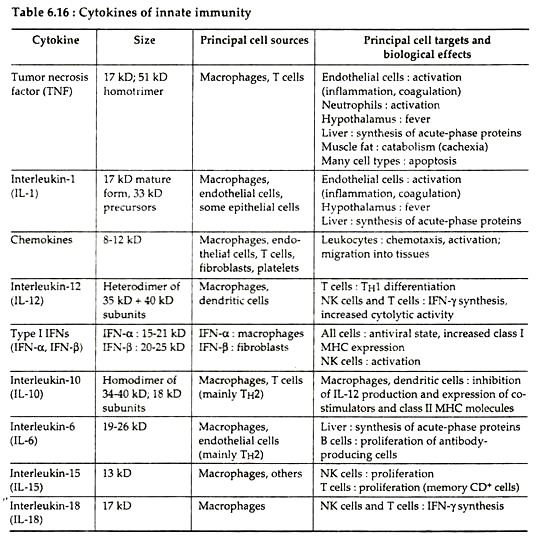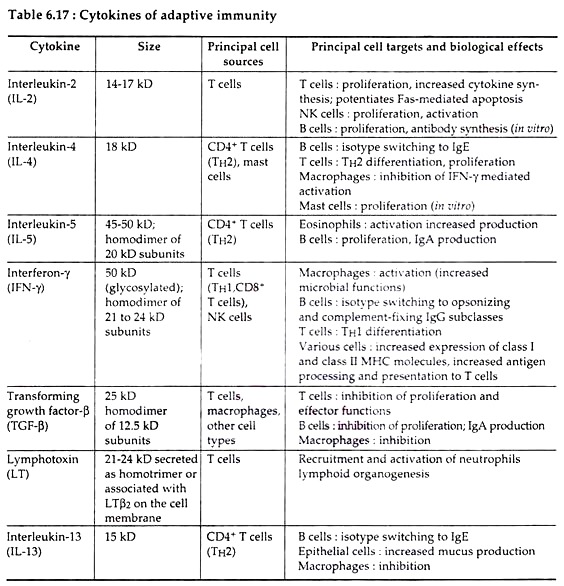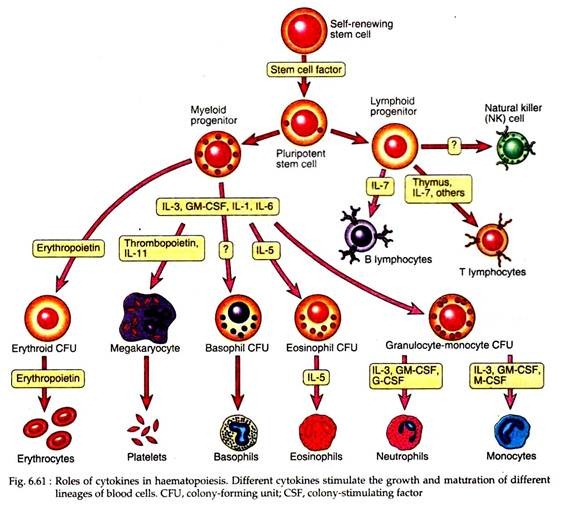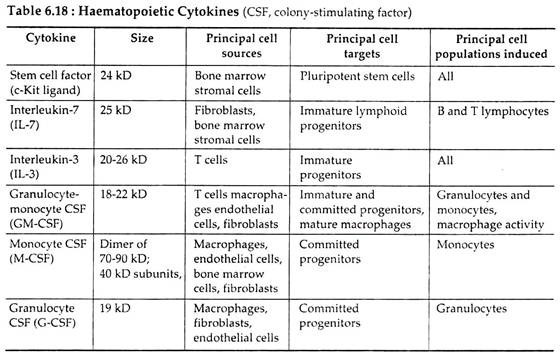In this article we will discuss about:- 1. Meaning of Cytokines 2. Nomenclature of Cytokines 3. General Characteristics 4. Receptors 5. Functional Categories 6. Related Diseases 7. Therapeutic Uses.
Contents:
- Meaning of Cytokines
- Nomenclature of Cytokines
- General Characteristics of Cytokines
- Cytokines Receptors
- Functional Categories of Cytokines
- Cytokine-Related Diseases
- Therapeutic Uses of Cytokines and their Receptors
1. Meaning of Cytokines:
Cytokines are low molecular weight regulatory proteins secreted by cells of innate and adaptive immunity in response to microbes and other antigens. Cytokines regulate the intensity and duration of the immune response by stimulating or inhibiting the activation, proliferation and/or differentiation of various cells and by regulating the secretion of antibodies and other cytokines.
ADVERTISEMENTS:
Thus they act as messengers of the immune system just as hormones serve as messengers of endocrine system.
2. Nomenclature of Cytokines:
The nomenclature of cytokines is often based on their cellular sources. Cytokines that are secreted by mononuclear phagocytes were formerly known as monokines, and those produced by lymphocytes were called lymphokines.
With the development of anti-cytokine antibodies and molecular probes, it became clear that secretion of many lymphokines and monokines is not limited to lymphocytes and monocytes as these terms imply, but extends to a broad spectrum of cells and types. For this reason, the more inclusive term cytokine is preferred for all such molecules.
ADVERTISEMENTS:
Many of the cytokines are referred to as interleukins because these are secreted by leucocytes and act on other leucocytes. This term is also imperfect because many cytokines that are synthesised only by leucocytes and that act only on leucocytes are not called interleukines.
For historical reasons, many cytokines are called interleukines but these are made by and act on cells other than leukocytes. Nevertheless, the term has been useful because as new cytokines are molecularly characterised. They are assigned as interleukins (IL) number (e.g., IL-1, IL-2, IL-3 and so on) to maintain a standard nomenclature.
3. General Characteristics of Cytokines:
Different cytokines are structurally diverse, thus they share several properties:
ADVERTISEMENTS:
(i) Cytokines bind to specific receptors on target cell membrane:
All cytokines initiate their action by binding to specific membrane receptors on target cells. Binding with receptors triggers the signal transduction pathways that ultimately alter gene expression in the target cells. Cytokines and their receptors show very high affinity for each other, with dissociation constant ranging from 10−10 to 10−12M. As a consequence, only very little quantities of cytokine are required to elicit a biological effect.
(ii) Cytokine secretion is a brief, self- limited event:
The synthesis of cytokines is transient, i.e., their synthesis is initiated by new gene transcription as a result of cellular activation. Such transcriptional activation is transient as the mRNA encoding most cytokines are unstable. Once synthesised, cytokines are rapidly secreted but never remain stored as preformed molecules.
(iii) The action of cytokines is pleiotropic and redundant:
A given cytokine may show different biological effects on different target cells – it is the pleiotropic action of cytokines. On the other hand, redundancy refers to the property of multiple cytokines having the same functional effects. Because of this property, mutation of one cytokine gene may not have functional consequences, as other cytokine may compensate its effect.
(iv) Cytokines show synergy, antagonism and cascade induction:
Cytokine synergism occurs when the combined effect of two cytokines on cellular activity is greater than that of the additive effects of the individual cytokine. In some cases, cytokines show antagonism that is, the effect of one cytokine inhibits or offset the effects of another cytokine. Cascade induction occurs when the action of one cytokine on a target cell induces that cell to produce one or more other cytokines which in turn may induce other target cells to produce other cytokines.
(v) Cytokines exert autocrine, paracrine and endocrine action:
ADVERTISEMENTS:
A particular cytokine may act on the same cell that secreted it, exerting autocrine action; it may act on a target cell in close proximity to the producer cell, exerting its paracrine action. In some cases, it may bind to target cells in distant part of the body, exerting its endocrine effect.
4. Cytokine Receptors:
The cytokine receptors are trans membrane proteins with extracellular portions that bind with cytokines and cytoplasmic portions that are responsible for initiating intracellular signaling pathways. On the basis of homologies among the extracellular cytokine binding domains, cytokine receptors are classified into five families:
(i) Immunoglobulin super family receptors
(ii) Class I cytokine receptor family (also known as haematoprotein receptor family)
(iii) Class II cytokine receptor family (also known as the interferon receptor family)
(iv) TNF-receptor family
(v) Chemokine receptor family.
5. Functional Categories of Cytokines:
Cytokines may be classified into three main functional categories based on their principal biologic actions.
1. Cytokines acting as mediators and regulators of innate immunity:
Different cytokines that regulate and mediate innate immunity are produced by mononuclear phagocytes in response to microbial agents such as lipopolysaccharide of bacteria, double stranded-RNA of virus etc.
These cytokines act mainly on endothelial cells and leucocytes to stimulate early inflammatory reactions to microbes, and some functions to control these responses. Examples of such cytokines, their sources and biological actions are tabulated in Table 6.16.
2. Cytokines acting as mediators and regulators of adaptive immunity:
These cytokines are mainly produced by T lymphocytes in response to specific recognition of foreign antigens. Many of such cytokines regulate the growth and differentiation of various lymphocytes. Thus, they stimulate the activation phase of T-cell dependent immune responses.
Other cytokines may recruit, activate and regulate specialized effector cells like mononuclear phagocytes, neutrophils and eosinophils to eliminate antigens in the effector phase of adaptive immune responses. For examples of such cytokines see Table 6.17.
3. Cytokines acting as stimulators of haematopoiesis:
Cytokines stimulating haemotopoiesis are produced by bone marrow stromal cells, leucocytes and other cells (Table 6.17. These cause stimulation of growth and differentiation of immature leucocytes (Fig. 6.61).
In general, the cytokines of innate and adaptive immunities are produced by different cell populations and act on different target cells. A comparative account of these cytokines is represented in Table 6.18.
However, these distinctions are not absolute because same cytokines may be produced during both innate and adaptive immune reactions. Moreover, different cytokines produced during such reactions may have overlapping actions.
6. Cytokine-Related Diseases:
Defects in the complex regulatory networks controlling the expression of cytokines and cytokine receptors may lead to various abnormal conditions. Both over-expression and under-expression of cytokines and their receptors may result in several diseases.
1. Bacterial septic shock:
When bacterial cell-wall cytotoxins stimulate macrophages to overproduce IL-1 and TNF-α, bacterial septic shock may develop. The symptoms of bacterial septic shock, which is very often fatal include a drop in blood pressure, fever, diarrhoea and blood clotting in various organs. Higher levels of TNF-α were found in patients who died of meningitis than in those who recovered.
2. Bacterial toxic shock:
Many microorganisms are known to produce toxins that act as super-antigens which, unlike the antigens, are not internalised, processed and presented by antigen presenting cells. The super-antigens can activate large number of T cells to produce excessive amount of cytokines. These elevated cytokines, in turn, can induce systemic reactions that include fever, widespread blood clotting and shock.
3. Lymphoid and myeloid cancers:
Development of some types of cancer is associated with the abnormal production of cytokines. For example, excessive high levels of IL-6 are secreted by cardiac myxoma cells, myeloma and plasma cytoma cells and cervical and bladder cancer cells.
In myeloma cells, IL-6 acts in an autocrine manner to stimulate cell proliferation. Monoclonal antibodies to IL-6 if added to in vitro cultures of myeloma cells, their growth was found to be inhibited.
4. Chagas’ disease:
Chagas’ disease is caused by the protozoan parasite Trypanosoma cruzi and is characterised by severe immuno suppression. It has been found that in presence of T. cruzi, T cells show a dramatic reduction in the expression of a subunit of IL-2 receptors, resulting in their inactivation of T cells with many antigens. These, in turn, lead to immunosuppression in patients with Chagas’ disease.
7. Therapeutic Uses of Cytokines and their Receptors:
From the above discussion it appeared that most cytokines are powerful mediators of innate and adaptive immunities. Now a days, a number of cytokines and soluble cytokine receptors have been purified and cloned. Many of such cytokines notably, Interferons and colony-stimulating factors, such as GM-CSF have proven to be therapeutically very useful.
Interferons:
Different types of interferons have antiviral activity and various other effects including the capacity to induce cell differentiation, to inhibit proliferation by some cell types, to inhibit angiogenesis and to function in various immunoregulatory roles.
Some examples include:
(i) INF-α (trade name Roferon and Intron- A) has been used for the treatment of hepatitis C, hepatitis B and many types of cancer. Chronic myelogenous leukemia, Kaposi’s sarcoma, non-Hodgkins lymphoma, cutaneous T-cell lymphoma and multiple myeloma etc. respond well to treatment with IFN-α.
(ii) INF-β. In the autoimmune neurologic disease multiple sclerosis (MS), a progressive neurologic dysfunction occurs. Treatment of that patients with IFN-p provides longer period of remission and reduces the severity of relapses.
(iii) IFN-y has found to be effective for the treatment of a rare hereditary disease, chronic granulomatous disease (CGD) where the patients’ phagocytic cells are seriously impaired to kill the ingested microbes. Therapy of CGD patients with IFN-y significantly reduces the incident of infections.
The use of interferons in clinical practice is likely to expand, particularly as more is learned about their effects in combination with other therapeutic agents. Although, a number of factors are likely to raise difficulties in adapting cytokines for safe and effective routine medical use.
These include the need to maintain appropriate dose levels, to formulate effective combination of cytokines with other drugs or cytokines, and in some cases, to control cytokines side effects or toxicity.
However, some cytokine-related therapies that either decrease or increase the immune response still offer promise of reducing graft rejection, treating certain cancers and immunodeficiency diseases, and reducing allergic reactions.



